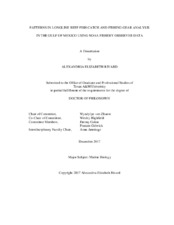| dc.description.abstract | The objectives of this study were to assess existing fishing practices (both spatial and gear use) employed by longline reef fish fishers in the Gulf of Mexico; to evaluate the gear and set parameters that contribute to catching larger individual fish of a target species; and to assess the gear and set parameters that contribute to successfully catching a fish of a target species. Data were collected by the Southeast Fisheries Science Center (SEFSC) Galveston Reef Fish Observer Program from 2006-2014. Explanatory variables included in the study were only those that could be manipulated directly by fishers: soak time, fishing depth, main line length, hooks deployed, gangion length, hook distance, and the temporal variables month and year.
Gear change assessments were conducted using analyses of variance for soak time, fishing depth, gangion length, hook distance, mainline length, and hook count across years. Significant differences were detected between years for all variables, however, there was no discernable trend over time. This suggests that fishing practices remained relatively stable from 2006-2014. Spatial analysis of catches was conducted for five species targeted during the study period (gag grouper, red grouper, scamp grouper, mutton snapper, and red snapper) using ArcGIS. However, no spatial trends were apparent given the uneven effort and coverage of the survey area.
To assess which fishing gear and set parameters contributed to catching the largest fish of a target species, ordinary least squares (OLS) linear models were used to predict iii
fish length as a function of the explanatory variables. Significant models were generated for blacknose shark, gag grouper, mutton snapper, red porgy, Atlantic sharpnose shark, and speckled hind.
Binomial regression models were constructed using backwards regression to predict target species catch success using the explanatory variables. Significant models were generated for speckled hind, red grouper, scamp, gag grouper, red snapper, mutton snapper, jolthead porgy, and red porgy. These models ultimately serve as guidelines for fishers to adjust fishing practices to improve the likelihood of successfully obtaining the targeted species, which may reduce bycatch mortality of non-target species and its resulting environmental impacts. | en |


